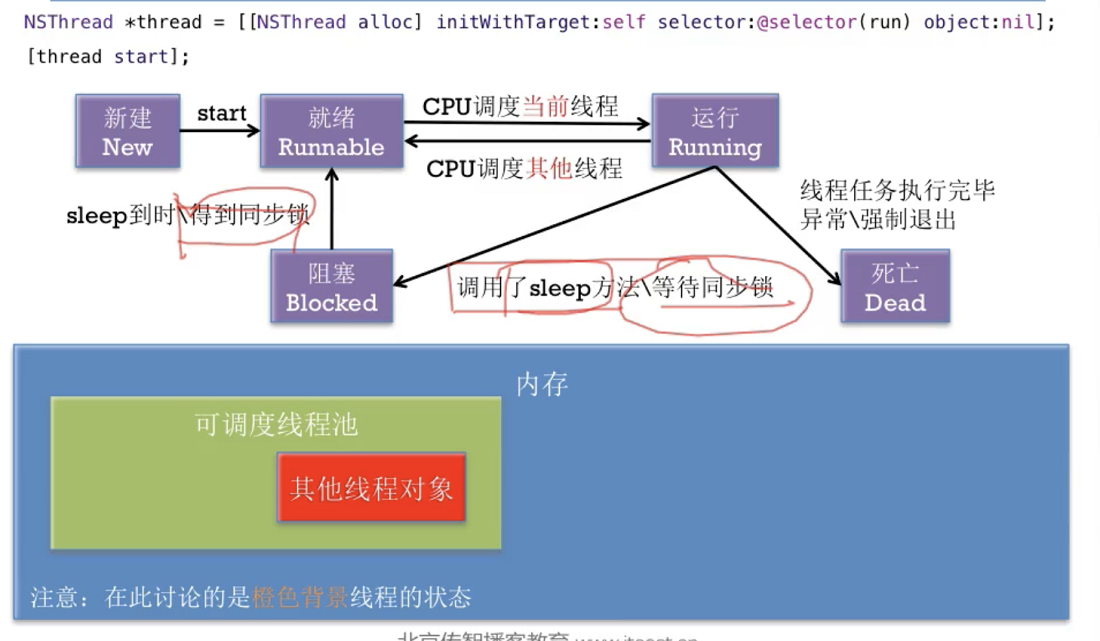一 概述- IOS中多线程的实现方案
| 技术方案 |
简介 |
语言 |
线程生命周期 |
使用频率 |
| pthread |
一套通用的多线程APi
适用于Unix\Linux\Windows等系统
跨平台\可移植 |
C |
程序员管理 |
几乎不使用 |
| NSThread |
使用更加面向对象
简单易用,可直接操作线程对象 |
OC |
程序员管理 |
偶尔使用 |
| GCD |
旨在替代NSThread等线程技术
充分利用设备的多核 |
C |
自动管理 |
经常使用 |
| NSOperation |
基于GCD(底层是GCD)
比GCD多了一些更加简单实用的功能
实用更加面向对象 |
OC |
自动管理 |
经常使用 |
二 pthread示例(不会阻塞主线程)
1
2
3
4
5
6
7
8
9
10
11
12
13
14
15
16
17
18
19
20
21
22
23
24
25
26
27
28
29
| #import "ViewController.h"
#import <pthread.h>
@interface ViewController ()
@end
@implementation ViewController
void *run(void *data)
{
NSLog(@"run----%@",[NSThread currentThread]);
for (int i=0;i<1000000; i++) {
NSLog(@"当前线程:%@====%d",[NSThread currentThread],i);
}
return NULL;
}
-(void)touchesBegan:(NSSet<UITouch *> *)touches withEvent:(UIEvent *)event
{
//创建线程
pthread_t myRestrict;
pthread_create(&myRestrict, nil, run, NULL);
}
@end
|
三 NSThread
3.1 概念
NSThread线程
一个NSThread对象就代表一条线程
创建、启动线程
1
2
3
| NSThread *thread=[[NSThead alloc]initWitchTarget:self selector:@selector(run) object:nil];
[thread start];
//线程一启动,就会在线程thread中执行self的run方法
|
主线程相关用法
1
2
3
| +(NSThread *)mainThread;//获得主线程
-(BOOL)isMainThread;//是否为主线程
+(BOOL)isMainThread;//是否为主线程
|
获取当前线程
1
| NSThread *current=[NSThread currentThread];
|
线程的调度优先级
1
2
3
4
| +(double)threadPrority;
+(BOOL)setThreadPrority:(double)p;
-(double)threadPriority;
+(BOOL)setThreadPriority:(double)p;
|
调度优先级的取值范围是:0.0~1.0,默认值0.5,值越大,优先级越高
线程的名字
1
2
| -(void)setName:(NSString *)n;
-(NSString *)name;
|
其他创建线程方式
创建线程后自动启动线程
1
| [NSThread detachNewThreadSelector:@selector(run) toTarget:self withObject:nil];
|
隐式创建并启动线程
1
| [self performSelecctorInBackground:@selector(run) withObject:nil];
|
上述2中创建线程方式的优缺点
3.2 代码
1
2
3
4
5
6
7
8
9
10
11
12
13
14
15
16
17
18
19
20
21
22
23
24
25
26
27
28
29
30
31
32
33
34
35
36
37
38
39
40
41
42
| #import "ViewController.h"
@interface ViewController ()
@end
@implementation ViewController
- (void)viewDidLoad {
[super viewDidLoad];
// Do any additional setup after loading the view.
}
-(void)download:(NSString *)url
{
NSLog(@"下载东西---%@--%@",url,[NSThread currentThread]);
}
-(void)touchesBegan:(NSSet<UITouch *> *)touches withEvent:(UIEvent *)event
{
[self createThread3];
}
//创建线程的方式
-(void)createThread1
{
NSThread *thread=[[NSThread alloc]initWithTarget:self selector:@selector(download:) object:@"http://1.jpg"];
thread.name=@"下载线程";
[thread start];
}
-(void)createThread2
{
[NSThread detachNewThreadSelector:@selector(download:) toTarget:self withObject:@"http://1.jpg"];
}
//线程创建方式3
-(void)createThread3
{
//[self performSelector:@selector(download:) withObject:@"http://aa.jpg"];
//[self download:@"http://aa.jpg"];
[self performSelectorInBackground:@selector(download:) withObject:@"http://aaa.jpg"];
}
@end
|
四 线程的状态
4.1 状态描述

4.2 线程的状态
启动线程
1
2
| -(void)start;
//进入就绪状态——>运行状态。当线程任务执行完毕,自动进入死亡状态
|
阻塞(暂停)线程
1
2
3
| +(void)sleepUnitilDate:(NSDate *)date;
+(void)sleepforTimeInterval:(NSTimeInterval)ti;
//进入阻塞状态
|
强制停止线程
注意:一旦线程停止(死亡)了,就不能再次开启任务
